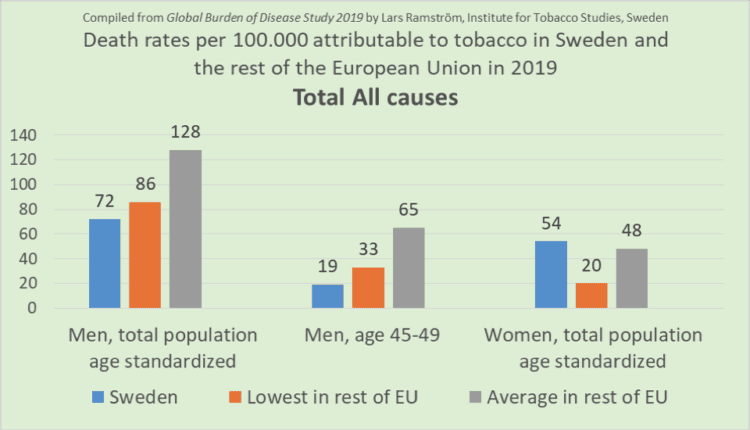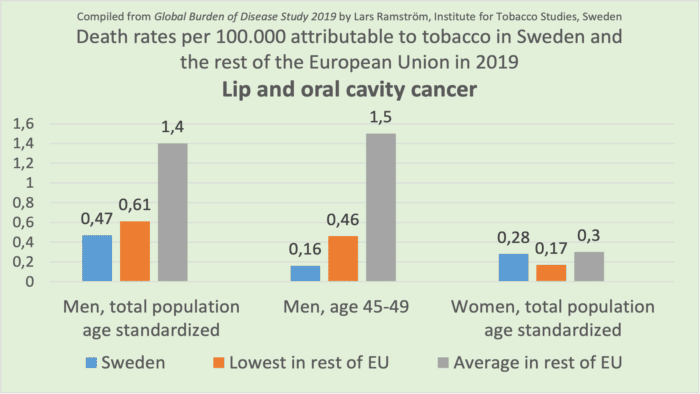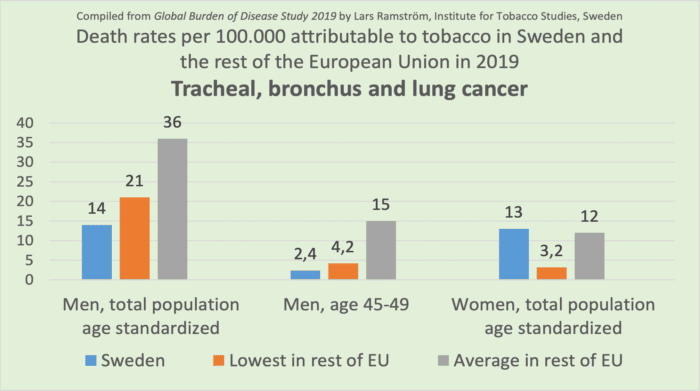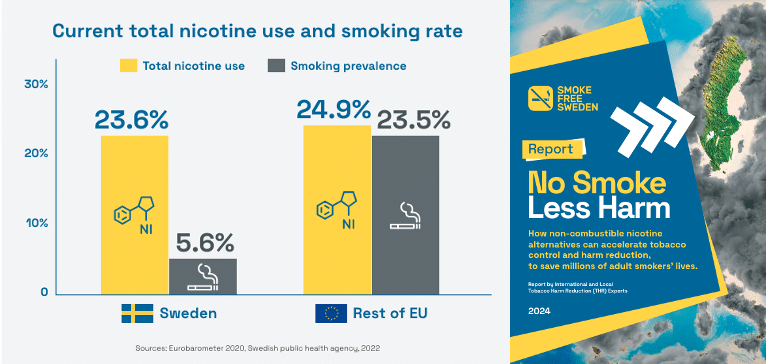
EU tobacco mortality: Snus a ‘major factor’ behind Sweden’s low rates
A new analysis of EU tobacco mortality rates reveals that snus use is a “major factor” in explaining why men in Sweden have a significantly lower chance of dying from tobacco-related illnesses compared to men elsewhere in Europe.
The study, carried out by Dr. Lars Ramström of the Institute of Tobacco Studies in Sweden, shows that Swedish men have a 44 percent lower tobacco-related mortality rate compared to men elsewhere in the EU.
“The results should be an eye opener for politicians and policymakers,” says Ramström.
The findings are based on an analysis of figures from the 2019 Global Burden of Disease study, an annual look at hundreds of causes of death in more than 200 countries.

Ramström used the extensive trove of data to carry out an age- and gender-based analysis of eight causes of death for which tobacco accounts for a considerable proportion of mortality. Specifically, the analysis looks at tracheal, bronchus, and lung cancer; lip and oral cavity cancer; larynx cancer; pancreatic cancer; ischemic heart disease; strokes; and COPD.
The findings confirm previous research by Ramström and others highlighting a situation unique to Sweden whereby the country’s overall high tobacco consumption levels (snus plus smoking) among men don’t correlate with low tobacco mortality rates.
The Swedish Experience
Dubbed the “Swedish Experience” with tobacco, the phenomenon continues to gain the attention of researchers interested in explaining why Sweden, where male tobacco use is dominated by snus use instead of smoking, is such an outlier compared to other countries in Europe when it comes to tobacco-related mortality.
Ramström’s latest analysis moves research forward by using age standardized data, thus compensating for differences in age distribution across countries which can give “misleading” impressions when comparing mortality rates.

The study examines tobacco-related mortality rates, comparing the situation for Swedish men and women with men and women in other EU countries. It also includes a break-out comparison for men aged 45-49, an age group where the dominance of snus over cigarettes is particularly pronounced among Swedish men.
“I wanted to look at populations where the difference in snus use was most pronounced in order to see if it results in an even greater difference in mortality rates,” Ramström explains.
Indeed, the study reveals the differences in tobacco-related mortality rates for Swedish men aged 45-49 are even more pronounced than in comparisons of the total populations. Further, men in Sweden aged 45-49 had lower tobacco-related mortality than men in any other EU country for every disease included in the analysis.
Gender and EU tobacco mortality
While Swedish men and women are exposed to the same tobacco-related restrictions and public health information, there is a gender dissimilarity when comparing tobacco-related mortality rates to the EU averages for men and women.
“The results show that tobacco-related mortality in Sweden is influenced by some determining factor that differs between men and women,” he says.
The “obvious” explanation for Sweden’s gender discrepancy in comparative tobacco-related mortality, he explains, is the difference in tobacco use patterns between men and women. While snus is the dominant form of tobacco among Swedish men, smoking remains dominant over snus among women in Sweden.
The results provide further evidence that Swedish men having the EU’s lowest level of tobacco-related mortality is connected to the prevalence of snus use instead of cigarettes.
“Snus must now be recognized as a major factor behind the ‘Swedish Experience’ with tobacco,” says Ramström.
He is quick to add that it’s important to take other factors into account, such as age restrictions, public information, and restrictions on where smoking is allowed.
However, Ramström points out that there appears to be a very weak correlation between the severity of tobacco control measures and public health gains measured by reduced tobacco-related mortality.
Public health education ‘essential’
He points to the Tobacco Control Scale, which quantifies the implementation of various tobacco control policies in different countries. In the most recent ranking from 2019, Sweden ranks 15 out of 36 countries.
“But if we speak about performance in terms of lower tobacco-related mortality, Sweden outperforms all the EU countries that rank ahead of it by significant margins,” he explains.
Unfortunately, such clear public health gains as measured by lower mortality rates are not always a top priority for tobacco control advocates.
“A number of organizations rely on a very unscientific approach and put too much emphasis on simply blaming the tobacco industry, whereas achieving public health benefits is secondary,” says Ramström.

He would like to see policymakers put more focus on reducing tobacco-related mortality by implementing harm reduction policies that would increase awareness and accessibility of snus and other safer tobacco alternatives.
Most smokers in most countries are not aware of the difference in personal health risks between snus and cigarettes, Ramström explains. In addition, individual smokers need to be convinced they will achieve personal health benefits by making the switch from cigarettes to snus.
“Official public health education about the vast differences in health effects is essential,” he says.




